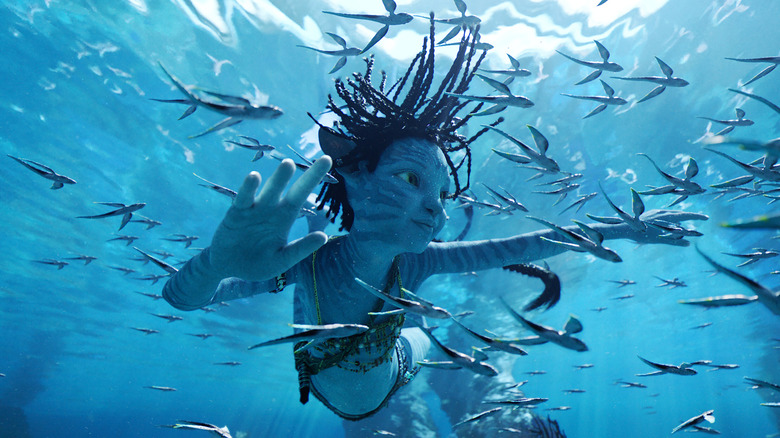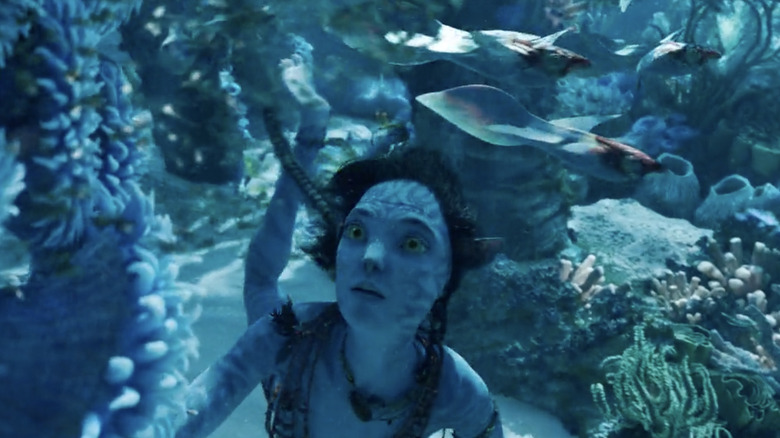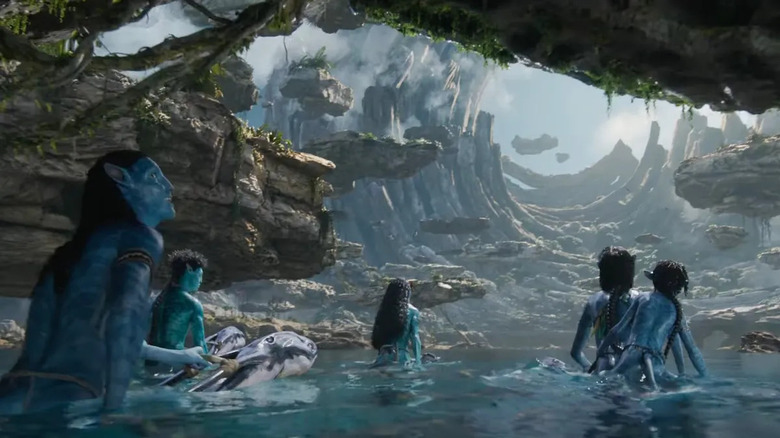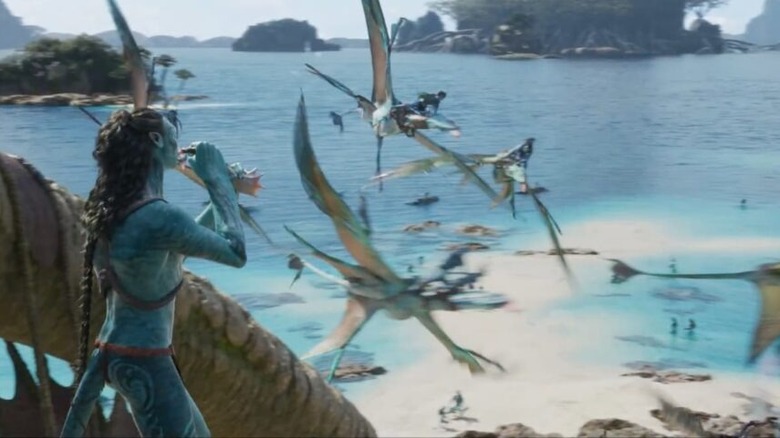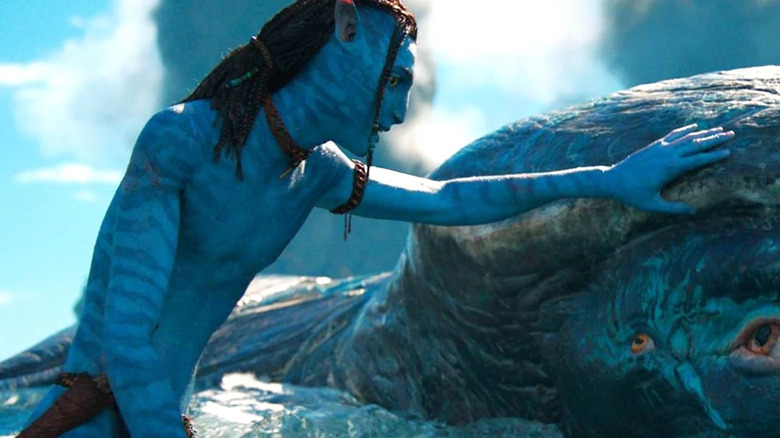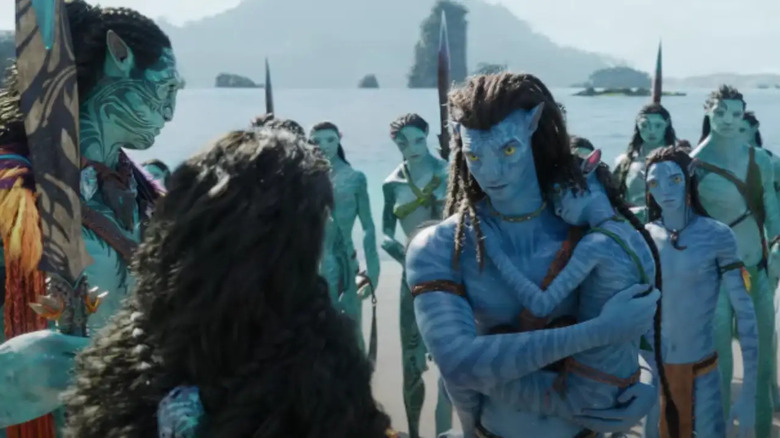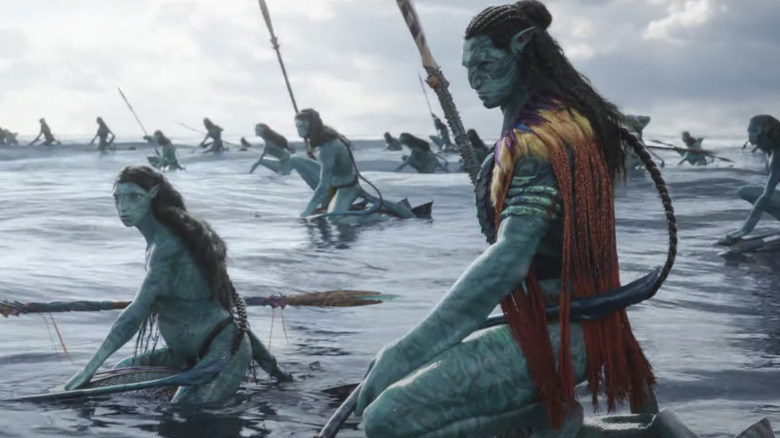Avatar: The Way Of Water's VFX Supervisors Discuss Creating The Film's Water And Wildlife [Exclusive Interview]
Filmmakers frequently tout the old "this movie couldn't have been made X years ago" boast, but in the case of "Avatar: The Way of Water," that idea actually holds a lot of weight. The weight of water, to be specific. Given that a vast majority of the movie takes place in and around the oceans of Pandora, the technology to create a believable underwater environment just wasn't available until recently.
In charge of Metkayina Village and the water surrounding it were, respectively, VFX supervisor Pavani Boddapati and FX supervisor Johnathan Nixon, both of Weta FX. I had the opportunity to speak with them recently, and they eagerly detailed their various challenges while making the movie, which included breaching Tulkun and incorporating costume design onto a digital character, as well as being inspired by the natural wonders of New Zealand.
Note: This interview has been lightly edited for clarity and brevity.
'There's tons of reference we shot'
Since both of you are jointly responsible for the majority of the ocean elements of this film, was it daunting to have to work for a man who's literally a deep sea diver, who's been down there multiple times?
Boddapati: Yes, yes. You had to make sure that either what you showed him that was computer graphics generated was just perfect, it needed to be very convincing, he says, "Okay, I buy it," or you needed to show reference that convinced him. There was no making up something on the fly. You had to be very, very sure, and this just goes beyond even water. Anything you show him, he's a very involved filmmaker. He knows what he wants. So for everything, we shot reference and we just made sure it just lined up perfectly to something we normally see outside.
You shot reference?
Boddapati: Tons!
What was that about?
Boddapati: Everything. From super cheap stuff. Like me and Alex, another effects supervisor, went down to the beach and shot ... you know the shot where Neytiri picks Tuk off the Ikran and she puts her down? That was my feet for the simulations from the sand because I was the smallest person that we could find to get the footprints. From something as cheap [as that]. We just popped down to the beach all the time. But we are also very close to Stone Street Studios where Jim is stationed and we have ability to shoot some stuff. We shot rain elements. We've shot reference for rain, we've shot reference for fire, like big elaborate flame throwers, and at the Manhattan Beach Lightstorm office, there's tons of reference we've shot.
Nixon: Yeah. And look, that's, at least for the effects department, that is what makes Weta special is how much, regardless of what film you're making, how important it is to base it in reality because that's what people see. You see a film and you can recognize, "Hey, that's what water looks like, I've seen that before." And the only way that you see that is by being able to create what you see. So we tell our artists all the time, specifically living in a place like New Zealand where you can't drive anywhere without seeing a body of water or the ocean or a bay, to get out there and film reference. What actually happens when a boat is planing over water? What actually happens when your feet are on the sand and it's a calm day? What happens when it's stormy and there's a storm that's 10 kilometers off in the distance, and what do those waves look like? Recreate it. That's where you start. And if you can start in that reality, then you can start to bend whatever Jim needs it to look like.
So for us, it was pretty inspiring to have someone who really understands what we do. You don't get that often — when someone really understands visual effects and they understand how to use it properly. So when you're having those discussions and you're showing him work and he is going, "That's not what this looks like, let's discuss what's actually happening in this shot," the artists pick up on that immediately. I think that becomes the language where it's not guessing. The artists aren't making guesses. They're not creatively going, "Well, I need to tweak this." They're going, "Nope, here's my reference. Here's what this looks like. Hey, Jim gave me a note. I don't know exactly what that looks like. Do we have reference for this or should I go out and shoot it?"
I mean, we had an artist on [Boddapati's] team that ... we were specifically doing crying bubbles underneath the water. And he went out there with his camera, he sat there, he did the motion, he did the crying bubbles and said, "Pavani, is this what this looks like?" We showed it to Jim. Jim goes, "That's perfect." And it's his reference. He filmed it and then he went there and recreated it in CG. Within our department in effects at Weta, that's what makes our work look so good, because we always base things in reality. Then that allows us to then bend the need of reality because you're making a film and you got to make it look the way that the director wants it.
Boddapati: That is usually a critical step in our process with Jim, is when a shot is turned over, we ask, "Well, what is it supposed to look like? Do you have an image in mind? A place in mind?" And he will give us a two liner. We'll go out and make sure, it could be some open source reference or something we shot, and we show it to him to say, "Is this what you meant?" "Oh, yes."
Once he approves, most of our presentations in the early days is a picture and picture [presentation]. We'll show the reference along with our simulation, or it could be even textures on a character, we shot something to just see what the pore detail looks like. But basing ourselves in physical reality is a big part of our visual effects process at Weta FX.
One of my favorite shots is this simple moment of Kiri looking at this hole in the sand underneath the water. Was any of that real or...?
Boddapati: We're never going to break down the shots. You tell me.
Well, I'll just say it punched me in the gut as an uncanny sight, like: "That's real!" It brought me back to my childhood of being on vacation. This is what I would do as a kid, stare under the water at the sand.
Nixon: The same thing as well is trying to get caustics. That's something that you maybe take for granted that we put a lot of work into exactly how are we going to get caustics to render on sand and [stuff] like that, so it looks like you're on an island or in a tropical place. That's all part of how you put the shot together, whether it's live-action or not, that's something that exists in reality that we can completely create in CG if we need to. If Jim has live photography that he really loves, we'll never take that away from a director. [If he] goes, "That's what I want. I've already filmed it. Give that to me." Perfect. But if he goes, "I need you to recreate that because it allows me to push and pull based on the characters, or I want to do it from a little bit of a different angle," we can do that as well.
Boddapati: And we can match it seamlessly. We can recreate it if needed.
The way of (creating) water
In terms of water, I remember going all the way back to playing a PS2 game with my buddy in high school and being like, "Oh, they can't do water yet." And now, I mean, this is so amazingly photorealistic. Is water still this huge daunting thing for effects artists, or has it gotten easier over the decades?
Boddapati: We were exactly like what you said at the beginning of the show six years ago. Like, "Oh my God, we're never going to be able to do this."
Nixon: I would say in our department of effects, we maybe had five people that you really trusted to do water, and you can't do this movie with five people. It's not enough people.
So a lot of what we did when we first joined the project was breaking down every single step of, "What is water?" Really just asking that question of, you've got a free surface and there's things that happen when you look underneath the water, when [you] drop an object in the water, what happens? When something breaches the water, what happens? So I would say that while it's still a difficult process because that state transition and exactly what makes aerated water or spray or mist or foam, all of those things can have a lot of different conditions of what makes that happen, it's a lot easier because we've built systems that allow for us to couple these things together where need be.
So one of the things that we used on a lot of the Tulkun hunt sequences was something that we call the state machine, which basically allows for you to run — a lot of the boats we ran automated, where you drop the boat in, you work with animation to get the timing of when it's planing and you basically run one simulation that says, based on how agitated our bulk surface is, based on where the boat is hydro planing, this is where you start to get processes of spray that then turns into mist, that then comes back in and folds back into that bulk water surface to make foam, and all of these different patterns. And that was run pretty much automated. We just ran it on the boats, looked at it, and said, "Okay, we need to tweak these settings based on the speed of the boat, based on how far in the water Jim wants the boat to be."
So, I would say it's easier because we've just built the framework for the artist to make that creative decision easier. Where that way, they can go, "Okay, I know I have a shot that needs some of these components, I can sort of build a system that allows for me to put these components together." And so a lot of our framework, which is called Loki, that our simulation team built, Loki allows for the artist to use kind of standard software like Houdini, but then to make those choices based on what's required. So we had about 127 artists at the end of this film, some of them who are fresh out of university who have never run water simulations before, [they] were doing hero shots that I would say before, four or five years ago, would've taken one of those really senior experts that are in high demand. And we have some really talented young people who are able to pick this up, understand the system, and run some of those shots.
Boddapati: The unique aspect is the capture performance. You have water effects in other films, too, but the idea here that you already have this capture of actors in the water and you need to preserve that, that adds the level of complexity that we haven't learned or worked with on previous shows. So that's one aspect that's very unique to Jim's filmmaking and this movie, is the captured performance. Because every shot has characters and actors who have already done the performance. So it's not a virtual character you can just put anywhere and run a sim. You've got to put them where they are, so the eye lines are there, the emotion is there, because they were captured together.
Designing Metkayina
When it comes to creating Metkayina village and all it encompasses, was it something that was a little bit harder to get at since it's not like a completely different planet, or was it easier because the planet's already established?
Boddapati: For me, that was the most exciting part, to be part of this world-building. It is a part of Pandora. It still needs to feel like they left High Camp and they flew and they suddenly saw this atoll and they entered and now they're in this village. But because it has the elements we are very familiar with, the people who live there use everything around them, they're part of nature. That part was the most critical part and that's what ties it to the rest of Pandora. They don't have supermarkets. It's people who love nature. They're living in the middle of it and they're using it. That was the most amazing part for me. I was super excited last night to watch the movie and [when] they fly [to Metkayina] ... and I've seen that shot a thousand times, I mean, I've worked on it for the last five years, but to see it and Tuk looks up and you see these mangrove forests and you're blown away. You're like, "Where is this place?" It's a part of Pandora. That was very exciting.
And it's all the details that Dylan Cole, the designer from Lightstorm, also our art department, Marco, who's our asset supervisor, we were all working together in making sure that [the] smallest detail ... what is the dressing? The dressing has to be things that the villagers are using. It has to be bottles and gourds and things you cook in. What are the materials these things are made of? It can only be something that's on that island within that atoll. So you can't have some material that doesn't exist. So it either has to be some sort of skin or wood or flax. So in a way, it's quite a limited palette, but not really, because the atoll is huge and there's so much variety in there.
Talkin' Tulkun
The Tulkun have such an amazing range of emotion and character without having the benefit of a face. Just the scale of them, believing this environment so much because of the scale of these creatures, what was that like putting that together?
Nixon: Yeah, and look, I think scale is the big theme for us in effects simulation. Because it's not just [about] a big giant third act. Payakan breached the water probably about 10 times in the movie. Tukluns were always breaching the water. We're like, "Man, there are some giant sims!" But it's also just the details with Lo'ak and Payakan. Like when Lo'ak wakes up and [there's the] Payakan rock gag and then you actually see all of the details. When he lifts his fin up and Lo'ak ducks underneath, just trying to sell that scale with Lo'ak, who's also very large compared to humans. But being able to set those two off in scale and show that connection was ... that's where we got to really show off some of our really detailed sim work. Because it's not only the big water and the big waves that Payakan generates, it's seeing those details on Lo'ak as well.
Sequences like that are really great, because it's not just big action where you can just kind of say, "Okay, we got a big [creature that is] basically size of a blue whale, this big giant creature jumping out of the water." He's got to interact with Lo'ak, too. That's where the emotion comes in. That's where he's talking to him. And where do the small drips [of water] on Lo'ak — he reaches his hand and the drip comes down his arm, and what's that in scale to Payakan? A drip on Lo'ak's gonna look much different from a drip on Payakan.
The Payakan scale was a tricky one, because that's where the artists really had to go, "Okay, we've got only so much reference of big, giant sea creatures breaching out of water, or big creatures sitting there kind of wading in water talking to another character. How do we sell that they're both in this environment and it doesn't look like there's a giant wave that would knock Lo'ak off, that he can comfortably be in this environment with him?"
So yeah, the scale was a big important one, because if we didn't get the very small detail, the capillary wave scale detail right, we weren't going to be able to sell the bigger detail, either. You had to sell both.
Boddapati: Scale is something — we're not thinking about it, but nothing in Pandora village, other than Spider, is human scale. But you believe it. Like when you land there, you believe that is the sand that you saw in a tropical island you visited at some point. But that forest that you're looking at is huge. It's probably as big as a giant mountain. And that was part of that design process in making the textures, in putting the right amount of aerial haze or putting little birds in there so you could sell scale. This thing is really big. Like Tuk is 5'10", you know? That's the scale you were working with.
Finding balance in collaboration
One of the main themes of the film is balance. And just listening to you talk about working on this, it feels like there's a really good amount of balance at Weta when it comes to communication, which to me, just as a layman who doesn't understand these things, it would be so daunting to be in charge of a little part of a shot and try to coordinate with however many other people. How do you feel from your perspective about the environment there?
Boddapati: It's very collaborative. Most of the people have been on the show for six years. Some people have been, like Joe Letteri, has never not been on the show since 2009. It's very collaborative, because we know that our combined goal is to make this movie that Jim wants to make and tell the story and make sure the performance comes through.
Because when I was watching the movie last night, to me, it's not an animated film. I see Zoe [Saldaña] and I see Sam Worthington, I see Sigourney Weaver. It's a performance movie. So the collaboration was very close. It's not just effects, working with Marco [Godinho], who's our effects supervisor with the textures team. We had our assets teams working, "Oh, we are building this model of the sea wall," which is when they come over, and asking Johnathan, "Hey, how should we build this model so that you're able to do efficient sims against it?" It's very collaborative, because it's a chain. Most departments are designed so that person A makes something, you hand it off to person B. With this kind of coupled simulations that Johnathan was talking about in this kind of movie, you really can't work linearly. You can't say, "I've delivered it. I'm done."
Nixon: It's very circular.
Boddapati: Sometimes we have designed loops of going A, B, C and then back to A for verification. So if the collaboration wouldn't have been there, we wouldn't have had this kind of success.
Nixon: And look, I would say that's one of the things that I think has gravitated a lot of people to Weta. We work on these big projects that require collaboration. You can't work in a vacuum in any of these departments because you are so tied together of, "I need the motion to work with my simulation" and vice versa. "I need the creatures with the hair and the cloth sims to work with the water, with the motion." It's all tied together. I think that's what makes Weta pretty special, is because we've built a pipeline that is flexible but also gives the guidelines and the rails where it needs to, but also allows for you to go backwards or, "Hey, I'm an effects guy. I need to go in here and tweak the things that I need to," because it's all coupled together, it's all in similar proprietary workflows and systems.
These are the special ones to work on at Weta, because it takes a lot of people. It takes most of [the] departments. It takes the effort of not even just the artists but the production crew to be able to talk to each other and [say], "Hey, this thing's coming off the wall and in the next hour, you're going to need to pick this up to make sure that we can get this shot out by tonight." And it's that at a massive scale. So yeah, it's not possible without collaboration. These films are special because it takes every ounce of the company to make them come to life.
And it's not just collaboration within Weta, it's collaboration with every filmmaker, effects house, and everyone involved.
Boddapati: And very close collaboration with Lightstorm. We've been working with them very closely, with Richie Baneham, with Dylan Cole, with Ben Procter, with Deb [Lynn Scott]. We will, just taking Deb as an example for costumes ... she's designed these amazing costumes.
I actually spoke to Deb a couple of months ago about the film.
Boddapati: She's so amazing. I love her. I mean, she is a legend. She's designed these amazing costumes. And she'll also shoot these movement tests. She'll have a person wearing her costume and she'll send us footage of how it moves so that we can use that to inform our sims. But then once that process starts, we also make sure — just as a small example, is we rendered one of the first shots, which is when the Sully kids are learning how to swim in the reef. And that was one of the first underwater shots we worked on. And underwater, depending on how far away you are from the camera, you lose red color. That's just the nature of water is the deeper you are and the further from the camera, you start losing reds, you hang onto blues. So she would take this costume that she's designed, which has a lot of red, and then we would put it underwater and say, "Hey Deb, sorry, we lost all the red, what do you want us to do?" And that starts the process of, "Oh, could we cheat something here? Maybe we need to crank up the reds. It's not going to look quite right outside, but this sequence's costume is designed for underwater."
So that's the kind of collaboration we have, until the very end of filing that shot, is working with her to say, "This costume looks exactly how you designed [it]," even though now it's in a different environment where, physically, it's going to look different.
'We're creating something that has a message'
One of the beautiful ironies of these films, and even this one maybe a little more than the first, is that they are movies made with a massive amount of technology that have such a great appreciation for nature. While working on this, have you two found yourselves learning more about our own world?
Boddapati: Absolutely. I have, to start with, because Jim and his wife, they talk about veganism and about trying to be vegan a few times a week. I did start doing that a few times a week. I think it makes a difference to the environment. But also, there is a message in this movie, right? It's all about that. And it makes you aware as you're watching it that we all need to be mindful so we can save a better planet for the next generation.
Nixon: I would say living in a place like New Zealand that has so much rich life and greenery and native species and things, living in New Zealand, working on a film like this, you do have a bit of an emotional attachment of, yeah, you can't drive to work in New Zealand without looking at bodies of water and an ocean and seeing some of the same things that we were creating. So yeah, I think it does make you take a second [and] pause when you see a film like that and you live in an environment where you see all of these different ecosystems and just taking that pause and saying, "Okay, we're creating something that has a message." Sometimes we make movies and they're kind of dumb and you blow stuff up, but it's cool. "Hey, this is awesome, I'm blowin' up buildings, this is great." But at the same time, when you get to work on something that looks as good as it does and has a bit of a meaning and a message to it, that's pretty special.
And there's a few explosions in this, too.
Nixon: Absolutely.
So that's nice.
Boddapati: Yeah.
Nixon: You get both.
Boddapati: Good balance.
"Avatar: The Way of Water" is in theaters everywhere.
